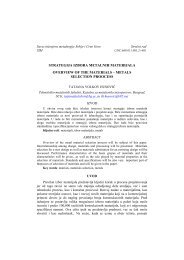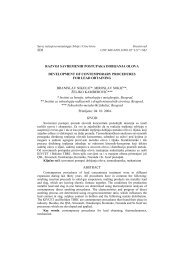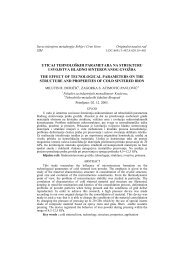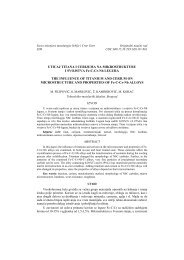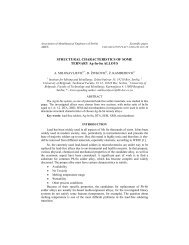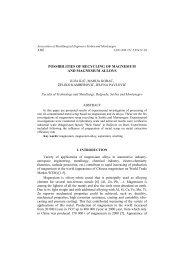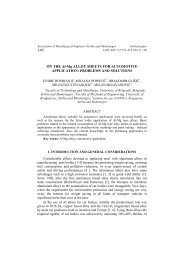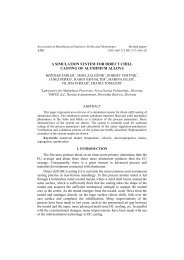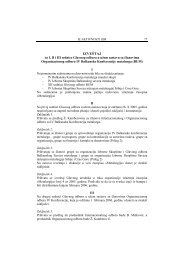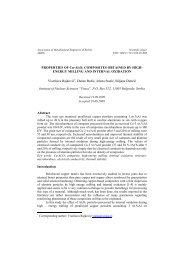THE INHIBITIVE EFFECT OF ETHANOLAMINE ON CORROSION ...
THE INHIBITIVE EFFECT OF ETHANOLAMINE ON CORROSION ...
THE INHIBITIVE EFFECT OF ETHANOLAMINE ON CORROSION ...
Create successful ePaper yourself
Turn your PDF publications into a flip-book with our unique Google optimized e-Paper software.
256 Metall. Mater. Eng. Vol 18 (4) 2012 p. 241-257<br />
supported as well by the electrochemical measurements and weight loss measurement<br />
results.<br />
Conclusions<br />
Ethanolamine is found to be good inhibitor for aluminium corrosion in 3 wt. %<br />
NaCl saturated with CO 2 with maximum inhibition efficiency around 80 % at a<br />
concentration of 5 mM of ethanolamine. Inhibition efficiency is then decreasing at<br />
higher concentrations of inhibitor. These results are confirmed by both, electrochemical<br />
measurements and weight loss measurements. From the Nyquist plot it can be seen that<br />
EIS response indicates the simple charge transfer process during aluminium dissolution.<br />
Addition of ethanolamine shifts the corrosion potential slightly in the positive direction<br />
without significant change in anodic and cathodic Tafel slopes. This suggests that the<br />
inhibition is accomplished by adsorption of ethanolamine molecules on to the<br />
aluminium electrode surface without changing the mechanism of partial corrosion<br />
reactions. Adsorption of ethanolamine follows Frumkin adsorption isotherm at<br />
concentrations up to 5 mM, whereas further increase in concentration of ethanolamine<br />
was found to deviate from Frumkin adsorption isotherm. The adsorption of the<br />
ethanolamine on aluminium surface is characterized by positive interaction coefficient<br />
of the Frumkin isotherm, indicating attractive lateral interactions in the adsorbed<br />
inhibitor layer. The negative value of standard free energy of adsorption, ∆G ads<br />
θ<br />
confirms that the adsorption process is favorable and spontaneous. The obtained value<br />
of ∆G ads θ lower than -20 kJ mol -1 indicates the pure physisorption process. Corrosion<br />
inhibitor concentration higher than 5 mM are probably causing lateral interaction<br />
between inhibitor molecules that are leading to inhibitor desorption resulting in the<br />
increase in corrosion rate. So it can be concluded that the corrosion of aluminium<br />
surface is under control of inhibitor molecules adsorption and desorption process.<br />
Acknowledgements<br />
This research was financed by the Ministry of Education and Science, Republic<br />
of Serbia, Grant III 45019.<br />
The authors would like to thank prof. Srđan Nešić, Institute for Corrosion and<br />
Multiphase Technology, Ohio University, OH, USA, for helping in discussion of the<br />
experimental results.<br />
References<br />
[1] D. Hasenay, M. Seruga, J. Appl. Electrochem. 37 (2007) 1001–1008<br />
[2] X. Li, S. Deng, H. Fu, Corros. Sci. 53 (2011) 2748–2753<br />
[3] R. Ambat, E. S. Dwarkadasa J. Appl. Electrochem. 24 (1994) 911-916<br />
[4] J. J. Heyrovsky, Discussions Faraday Soc. 1 (1947) 212<br />
[5] J.B. Bajat, J.P. Popić, V.B. Mišković-Stanković, Prog. Org. Coat. 69 (2010)<br />
316–321<br />
[6] Z.Ž. Lazarević, V.B. Mišković-Stanković, Z. Kačarević-Popović, D.M. Dražić,<br />
Corros. Sci. 47 (2005) 823–834<br />
[7] V.B. Mišković-Stanković, M.R. Stanić, D.M. Drazić, Prog. Org. Coat. 36 (1999)<br />
53-63<br />
[8] S. A. Ali, M.T. Saeed, S.U. Rahman, Corros. Sci. 45 (2003) 253–266<br />
[9] A. Döner, G. Kardas, Corros. Sci. 53 (2011) 4223–423




